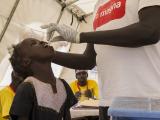Oct 5, 2011
ECMO shown to benefit very ill H1N1 patients
Among patients with 2009 H1N1 pandemic flu who experienced severe acute respiratory distress syndrome (ARDS), those receiving extracorporeal membrane oxygenation (ECMO) had significantly higher survival rates compared with matched controls who did not receive ECMO, a UK study published today by the Journal of the American Medical Association (JAMA) found. Researchers reported that, of 80 patients referred for ECMO in one of the four UK hospitals equipped for such specialized care, 22 (27.5%) died. Of 209 matched hospitalized patients who were not referred for ECMO, however, 110 (52.5%) died. The authors write, "The results were robust to sensitivity analyses, including amending the inclusion criteria and restricting the location where the non–ECMO-referred patients were treated." Both the authors and William Checkley, MD, PhD, of Johns Hopkins University, who wrote a companion JAMA editorial, cite several study limitations. Checkley, for example, discussed the difficulty of untangling whether the noted benefit was from ECMO itself or simply from being treated in a highly specialized unit. Noting the results of this and several other studies, he concludes, "In light of the large observed differences in mortality with and without ECMO, large consortia of trialists may be enticed to consider ECMO as a potential target for a randomized controlled trial early in the course of severe ARDS from all causes."
Oct 5 JAMA study
Oct 5 JAMA editorial
Cholera epidemic in Haiti, Dominican Republic sparked 23 US cases
The year-old cholera epidemic in Haiti and the Dominican Republic has triggered a big increase in cases in the United States, according to a report published today by Emerging Infectious Diseases. Researchers say 23 US cases were reported from November 2010 to early April 2011, compared with an average of 6 cases annually from 2000 to 2010. Florida, the state with the largest Haitian population, had the most cases, with 10. Thirteen of the patients reported traveling to Haiti and 9 to the Dominican Republic, and the other one ate seafood from Haiti. Nine patients were hospitalized, but none died. All nine patients who had gone to the Dominican Republic had attended the same wedding. Most of the people traveled to the countries to visit friends or relatives, but four went there to help with medical or other relief activities. The article notes that person-to-person spread of cholera is rare, and most cases, including in medical workers, stem from contaminated food and water. Until the epidemic ends, the authors say, clinicians, microbiologists, and public health workers in the United States should be prepared for more cases in returning travelers.
Oct 5 Emerg Infect Dis report
Smaller workforce will not hinder USPS anthrax response: official
Budget woes and recent cuts in US Postal Service (USPS) staff will not affect the delivery of antibiotics in the event of an anthrax attack, according to a Security Management story yesterday. Jude Plessas, USPS manager of countermeasures distribution and delivery, said, "We're required to provide universal service and delivery to every address. If there's a consolidation in a particular city, that doesn't affect the way deliveries are taken care of." In fact, the antibiotics-delivery program is progressing steadily under federal grants, according to the story. In a Minneapolis-St. Paul area pilot program, officials estimate that 179 volunteer USPS carriers can deliver drugs to 575,000 people in a day. The story said the agency has cut 110,000 workers in the past 4 years.
Oct 4 Security Management story
WHO says guinea worm disease close to elimination
Public health professionals may be close to eliminating dracunculiasis, or guinea worm disease, the World Health Organization (WHO) said in a new fact sheet. The agency reported 1,797 global dracunculiasis cases in 2010, down from 4,619 in 2008 and 3,190 in 2009—compared with 3.5 million cases in the mid 1980s. The number of affected countries has also dropped dramatically, from 20 in the 1980s (16 in Africa) to just 4 today: Chad, Ethiopia, Mali, and South Sudan. The WHO said that to be declared free of dracunculiasis, a nation must have zero disease transmission and then maintain active surveillance for at least 3 years. The crippling parasitic disease is caused by Dracunculus medinensis, a long thread-like worm, and is transmitted exclusively via drinking water contaminated with parasite-infected water fleas. The WHO said that finding and containing the last remaining cases may be the most difficult stage of the elimination process, because cases typically occur in hard-to-reach rural areas.
October WHO fact sheet
Indonesia plans for WHO collaborating center
Indonesian officials have proposed that a biosafety level 3 (BSL-3) laboratory planned for the health ministry be certified as a WHO collaborating center to focus on zoonotic disease research, the Jakarta Post reported yesterday. The lab would be operated by the National Institute of Health Research and Development, a division of Indonesia's health ministry, according to the report. Currently, the country has few certified BSL-3 labs, which include facilities at the Eijkman Institute at the University of Indonesia Medical School in Jakarta and Airlangga University in Surabaya, East Java. Graham Tallis, who leads a WHO surveillance and response team in Indonesia, told the Post that the lab will focus on the human-animal interface of H5 avian influenza. "Indonesia has a lot of experience with the H5 virus. By collaborating with the WHO, it will help us further knowledge, research, and surveillance of H5," he said, adding that of about 100 WHO collaborating centers, Indonesia's will be the first to focus on the human-animal influenza interface.
Oct 4 Jakarta Post story


















